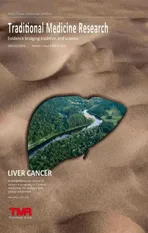A comprehensive review of research progress in Chinese medicines for primary liver cancer treatment
2022-02-26KuiLiaoLeYiGongYiYangYiMeiHeFangLiangWangYuanQiongHuangZhiGuiWu
Kui Liao,Le-Yi Gong,Yi Yang,Yi-Mei He,Fang-Liang Wang,Yuan-Qiong Huang,Zhi-Gui Wu
1Department of Pharmacy, Affiliated Hospital of Southwest Medical University, Luzhou 646000, China.2School of Pharmacy, Southwest Medical University,Luzhou 646000,China.3Department of Nephropathy,Luzhou Traditional Chinese Medicine Hospital,Luzhou 646000,China.
Abstract Primary liver cancer seriously threatens human health, affects the quality of life, and has a high mortality rate.Traditional Chinese medicine (TCM) has long been used in the prevention,treatment, and adjuvant treatment of primary liver cancer.Clinical trials were conducted in recent years to evaluate the efficacy and safety of TCM.The mechanism of action of TCM in primary liver cancer treatment also received extensive attention.This study summarizes the common monomial Chinese herbal medicines and their components, formulae, and the proprietary Chinese medicines used to treat primary liver cancer.Common medicines include Chansu (Bufonis venenum), Kushen (Sophorae flavescentis radix), Renshen (Ginseng radix et rhizoma), and Jianghuang (Curcumae longae rhizoma).This study also reviewed the literature on liver cancer treatment using TCM.The results confirmed the safety and efficacy of TCM in liver cancer treatment.The possible mechanisms involved are also listed, including influencing the cell cycle, inducing cancer cell apoptosis and autophagy, inhibiting cancer cell angiogenesis and metastasis,regenerating the microenvironment and DNA methylation, and regulating the innate immune response.For primary liver cancer patients who often have a long disease course,Chinese herbal medicine often plays a role in protecting and conditioning the body.Research aimed at finding more traditional Chinese herbal medicines and their mechanisms of action should be promoted.This study aimed to provide a scientific reference for further research and the rational clinical application of TCM for primary liver cancer treatment.
Keywords: primary liver cancer; traditional Chinese medicine; clinical evaluation;pharmacological mechanism
Background
Cancer is the second leading cause of death worldwide and poses a serious threat to human health [1].Primary liver cancer (PLC), one of the most common causes of cancer deaths globally [2], is ranked fifth in the cancer incidence rate, second in all cancer deaths, and third in cancer mortality [3].PLC includes three pathological types:hepatocellular carcinoma (HCC), intrahepatic cholangiocarcinoma(ICC), and HCC-ICC mixed type[4].The United States was expected to have 42,230 new HCC and ICC cases and 30,230 new deaths in 2021[5], ranking second and third in cancer mortality factors for men and women in China, respectively [6].Hepatitis, non-alcoholic fatty liver[7, 8], obesity, diabetes, and heavy drinking are all common risk factors.
Common treatment methods include surgical resection, liver transplant, chemotherapy, and ablation [9].Chemotherapy is the first choice of treatment for advanced liver cancer.Transcatheter arterial chemoembolization (TACE) is the first choice in clinical practice.However, there are some challenges, including postoperative recurrence, liver donor scarcity, drug resistance, the long-term toxic effects of chemotherapy drugs,and poor recovery.The development of a safe and effective treatment method is urgently required.Many clinical studies report a favorable effect of traditional Chinese medicine (TCM) on improving the symptoms associated with advanced PLC [10], reducing tumor recurrence [11], and controlling disease progression.In China and some Southeast Asian countries,TCM preparations have been used for the clinical treatment of malignant tumors, including PLC [12].Clinical research confirmed that TCM, used as adjuvant therapy, can likely prolong the median survival time and improve overall survival rates among HCC patients[13].In the current treatment based on the integration of traditional Chinese and Western medicine, TCM preparations combined with TACE in liver cancer treatment reduce alpha-fetoprotein levels and the incidence of the toxic and adverse effects of TACE.In addition, TCM preparations can improve cellular immune function and natural killer cell levels in post-operative liver cancer patients.An in-depth clinical study of the efficacy and safety of integrated traditional Chinese and Western medicine in the prevention and treatment of PLC will further improve our understanding.
Cancer development consists of multiple complex stages, including initiation, promotion, and progression, and it depends on inflammatory reactions, angiogenesis, and host immunity reduction.Most cancer patients also present with a decline in immunity during the middle and late stages of cancer [14].Inflammation contributes to the development of cancer and promotes all stages of tumorigenesis[15], while angiogenesis exacerbates cancer cell proliferation and metastasis.Eliminating the existing tumor blood vessels and preventing new blood vessel formation to restrict tumor cell nutrition is a common clinical method used to prevent angiogenesis.This inhibits the infiltration of the primary tumor and prevents angiogenesis during metastasis [16].Existing studies reported that the mechanisms involved in TCM tumor therapy include inducing cancer cell apoptosis and autophagy, inhibiting the autophagy of normal cells,promoting cell cycle arrest, changing the tumor microenvironment,inhibiting cancer cell angiogenesis and metastasis, anti-inflammation,anti-oxidation, and immunosuppression.TCM presents anti-inflammatory, immune regulation, inhibition of blood vessel regeneration, and other effects.We, therefore, support the application of TCM in all stages of PLC development.For example, alkaloids can prevent and treat cancer.Their anti-tumor mechanism does not directly kill cancer cells but promotes apoptosis, autophagy, necrosis,cell cycle disruption, and the inhibition of cell growth, proliferation,differentiation, migration, and invasion [17].Additionally, TCM has the advantages of low toxicity, strong specificity, and high efficiency in cancer treatment, and therefore plays a positive role in the medical care system [18].
Cancer treatment using TCM has a long history.In the Yin Dynasty(1600 B.C.E.-1046 B.C.E.), oracle bone inscriptions unearthed in Anyang, Henan city in China, described the lump in a female breast as“like rock potholes and holes, hard and impregnable”.Until recently,Taiwanese folk used to call breast cancer “milk rock”.In the 12thcentury B.C.E.,Zhou Li · Tian Guan(written in the Warring States period (770 B.C.E.-476 B.C.E.) by Gong-Dan Zhou) reported that“eight doctors were selected to take charge of diseases such as swelling and ulcerations”.An-Shi Wang (1021 C.E.-1086 C.E.) in the Song Dynasty reported it as“swelling and ulceration gather but do not disperse”.Until recently, tumors in South Korea and Japan were called“swelling and ulceration”.In addition, the references“tongue bacteria,regurgitation, andPneumocystis”, which are scattered throughout ancient literature, are all descriptions of the clinical manifestations of modern malignancies.
TheYellow Emperor’s Internal Classic(written in the 2ndcentury B.C.E., unknown author) summarized previous clinical records, which led to the establishment of a theoretical system using TCM holistic concept principles and dialectical theory treatment, focusing on the causes, symptoms, diagnosis, treatment, prognosis, and prevention of tumors.TCM principles state that “stagnation of Qi and blood”(stagnation of Qi and blood is a common disease in TCM, and refers to slowing or inhibition of the normal flow of a bodily fluid or semifluid)leads to tumor formation, which is the basis of TCM tumor treatment.The efficacy of Jingjie (Schizonepetae herba), a common herb, in“dissipating stasis and breaking Qi” was first recorded inthe Compendium of Materia Medica(written in 1552 C.E.-1578 C.E.by Shi-Zhen Li).It has a variety of pharmacological activities, including anti-tumor, anti-inflammatory, analgesic, antiviral, and bacteriostatic effects [19-21].In clinical studies,Schizonepetae herbaor Chinese herbal remedies based onSchizonepetae herba(like the TCM prescription Zhiyi powder and Yinqiao powder, which are effective at cough relief and resolving phlegm, clearing away heat and detoxication) have also been used to treat cancer and related diseases[22].In addition, Sanqi (Notoginseng radix et rhizoma), which is distributed throughout the southwest of China, Burma, and Nepal, is a remedy with a long history of use in China and other Asian countries.The earliest scientific description was inthe Compendium of Materia Medica.Notoginseng radix et rhizomais traditionally used to promote blood circulation,remove blood stasis,eliminate lumps,and restore Qi.Recent studies reported thatNotoginseng radix et rhizomashowed anti-tumor effects [23, 24].Lin et al.discovered its therapeutic effect on liver cancer [25].
TCM recently became part of modern PLC research and comprehensive treatment [26].The liver protection prescriptions currently available on the Chinese market and the clinically applied TCM preparations.The efficacy and safety of the substances were determined using real-life clinical treatment cases.The effect and mechanism of anti-PLC monomer components of TCM were also demonstrated (Figure 1).The review aimed to provide a scientific reference for further research and rational clinical application of TCM therapy for PLC.
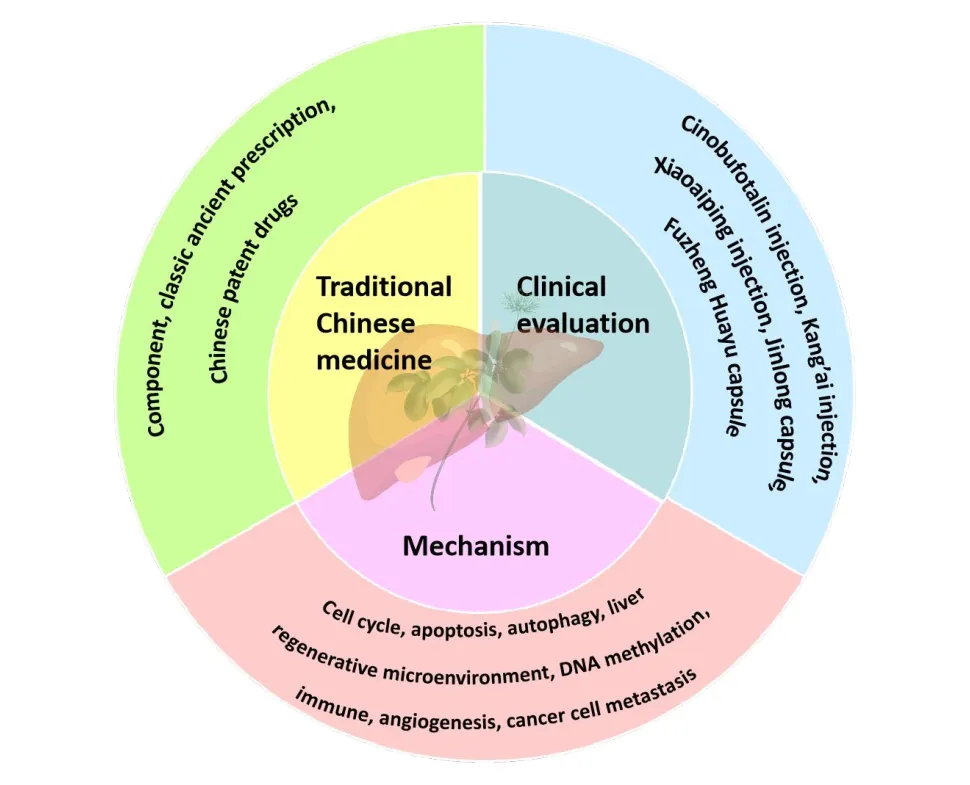
Figure 1 The effective anti-primary liver cancer monomer components of traditional Chinese medicine
Commonly prescribed TCM in the treatment of PLC
As an anti-cytotoxic and physique strengthening drug, TCM has long been proven to play a significant role in alleviating clinical symptoms,improving quality of life and immune function, preventing recurrence and metastasis, delaying tumor progression, and prolonging the survival time of cancer patients [27, 28].An increasing number of clinical and experimental studies reported that TCM and its extracts have unique therapeutic effects on PLC [12].TCM plays an important role in cancer treatment and immune regulation.The unique immune tolerance environment of PLC often leads to tumor escape,progression,and metastasis, which can be reversed with TCM [10].TCM can be used as an adjuvant treatment to improve the survival rate, reduce drug-related adverse reactions, and improve the quality of life of patients with end-stage cancer.
Common single Chinese medicine has been studied in-depth,producing great achievements in modern pharmacology and efficacy.It is one of the various approaches used to develop new drugs and is based on the active TCM components, enabling the discovery of new effective monomer compounds.Curcumin, berberine, and sulforaphane from Chinese herbal medicines can activate blood circulation and detoxification, and have been used for the treatment of liver cancer.Research on the treatment of HCC using the monomer components of TCM has increased greatly.Shang et al.found that Tiepishihu (Dendrobium officinale) polysaccharides significantly inhibited human hepatocellular carcinomas HepG2 cell proliferation in a dose-dependent and time-dependent manner [29].Da et al.discovered the synergistic effects of berberine and chemotherapeutic drugs in inhibiting tumor proliferation by inducing cell cycle arrest,apoptosis, and autophagy [30].Research on the disease resistance mechanism of monomers and their effective components provide a basis for further screening, setting and optimizing the compatibility ratio, and exploring the mechanism of resistance of TCM compounds.
Prescriptions, which are combinations of various Chinese herbal medicines, require appropriate dosage regimens based on the patient’s condition, drug properties, and treatment requirements.Chinese patent medicine consists of a fixed prescription and is suitable for broad-spectrum use.A series of proprietary Chinese medicines,represented by Kang’ai injection (approval number by Food and Drug Administration in China: Z20026868).Effect, replenishing Qi and strengthening the body’s immune function, have gained great popularity in the alternative and complementary treatment of advanced PLC.In this study, we collected mainstream anti-liver cancer prescriptions and Chinese patent medicines (Tables 2 and 3) and analyzed their compositions and efficacy.
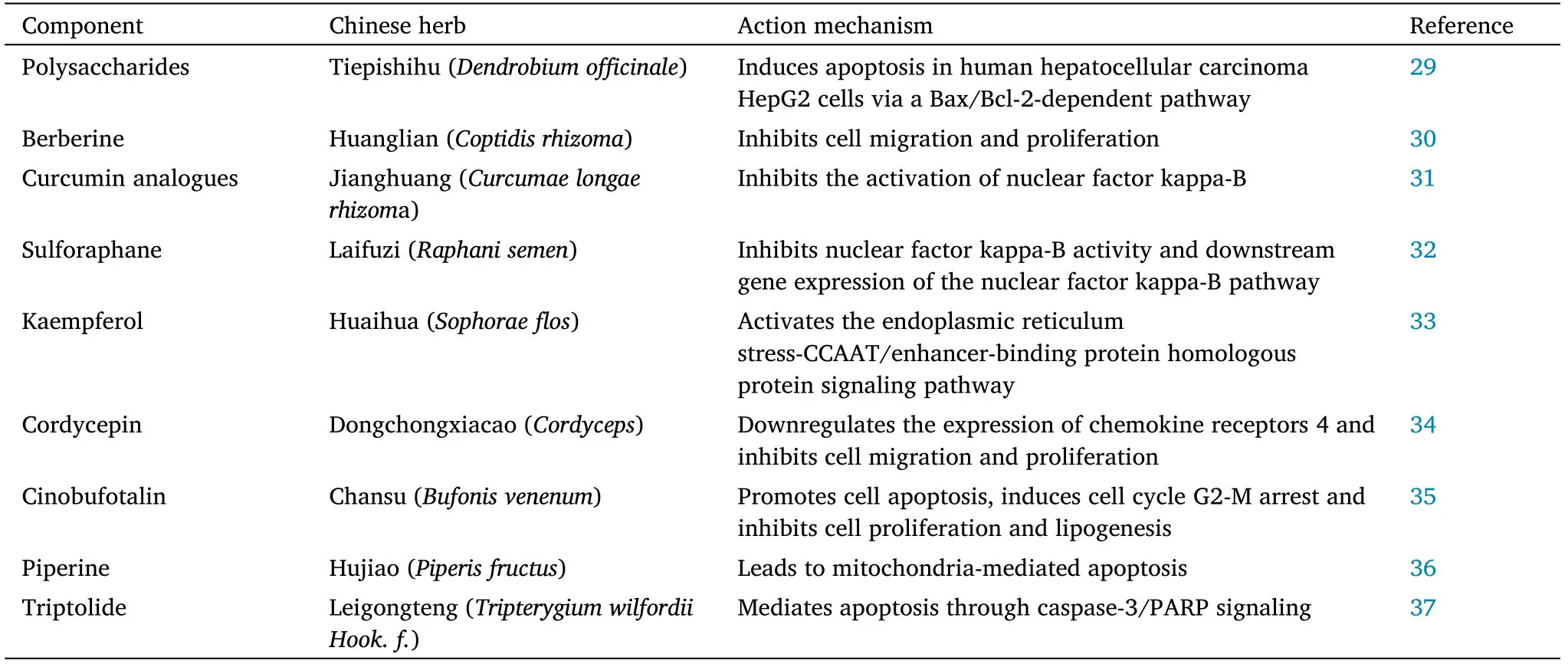
Table 1 Lists the current research hotspots for anti-liver cancer traditional Chinese medicine

Table 2 A common classic ancient prescription for treating primary liver cancer
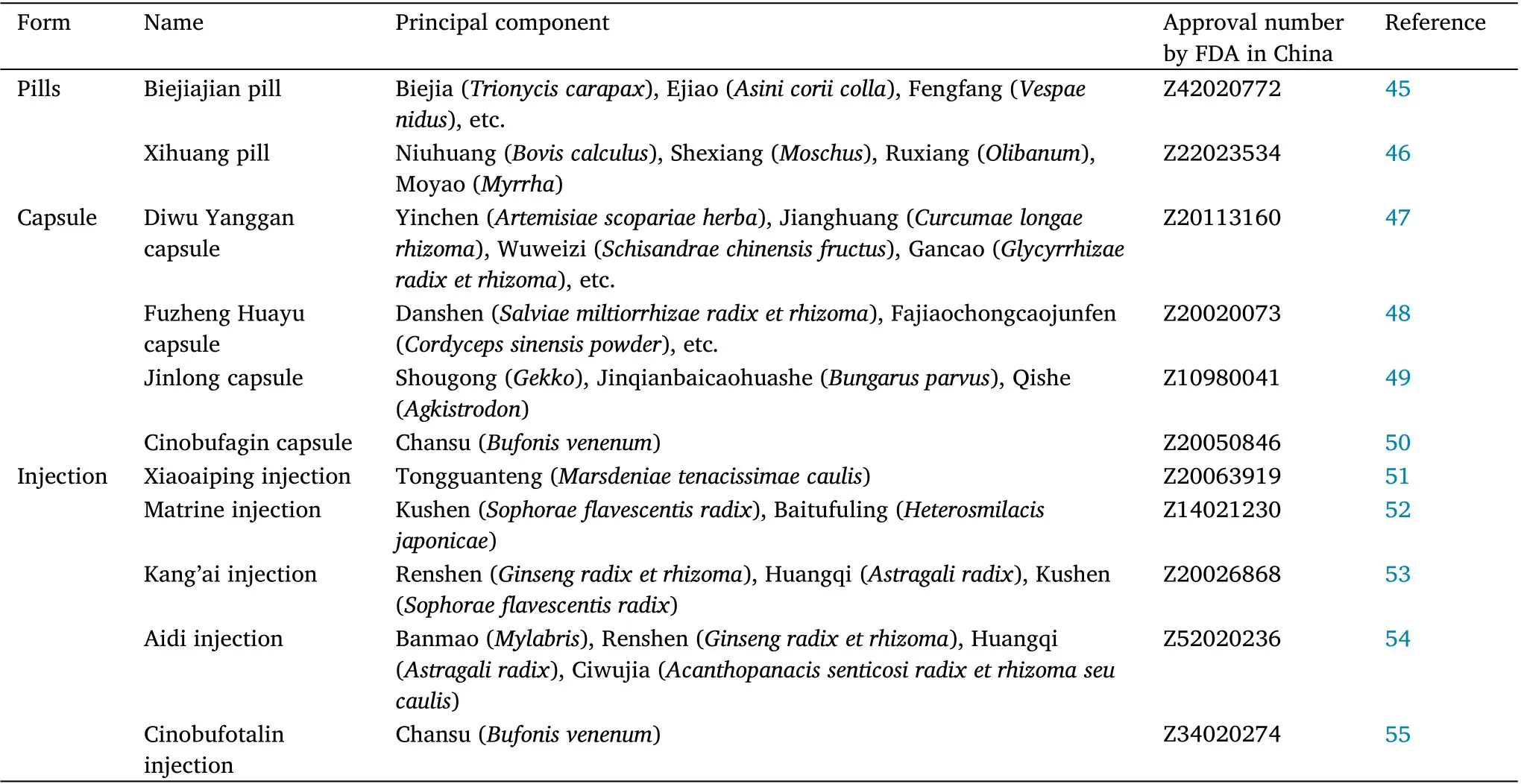
Table 3 Commonly used Chinese patent drugs against primary liver cancer
Clinical evaluation of the curative effect of TCM
A major obstacle to the modernization of TCM is a lack of rigorous clinical and scientific evaluation.Several double-blind, controlled,randomized trials were conducted to evaluate the efficacy of TCM in liver cancer treatment.Some of the most prevalent proprietary Chinese medicines were also clinically evaluated (Table 4).
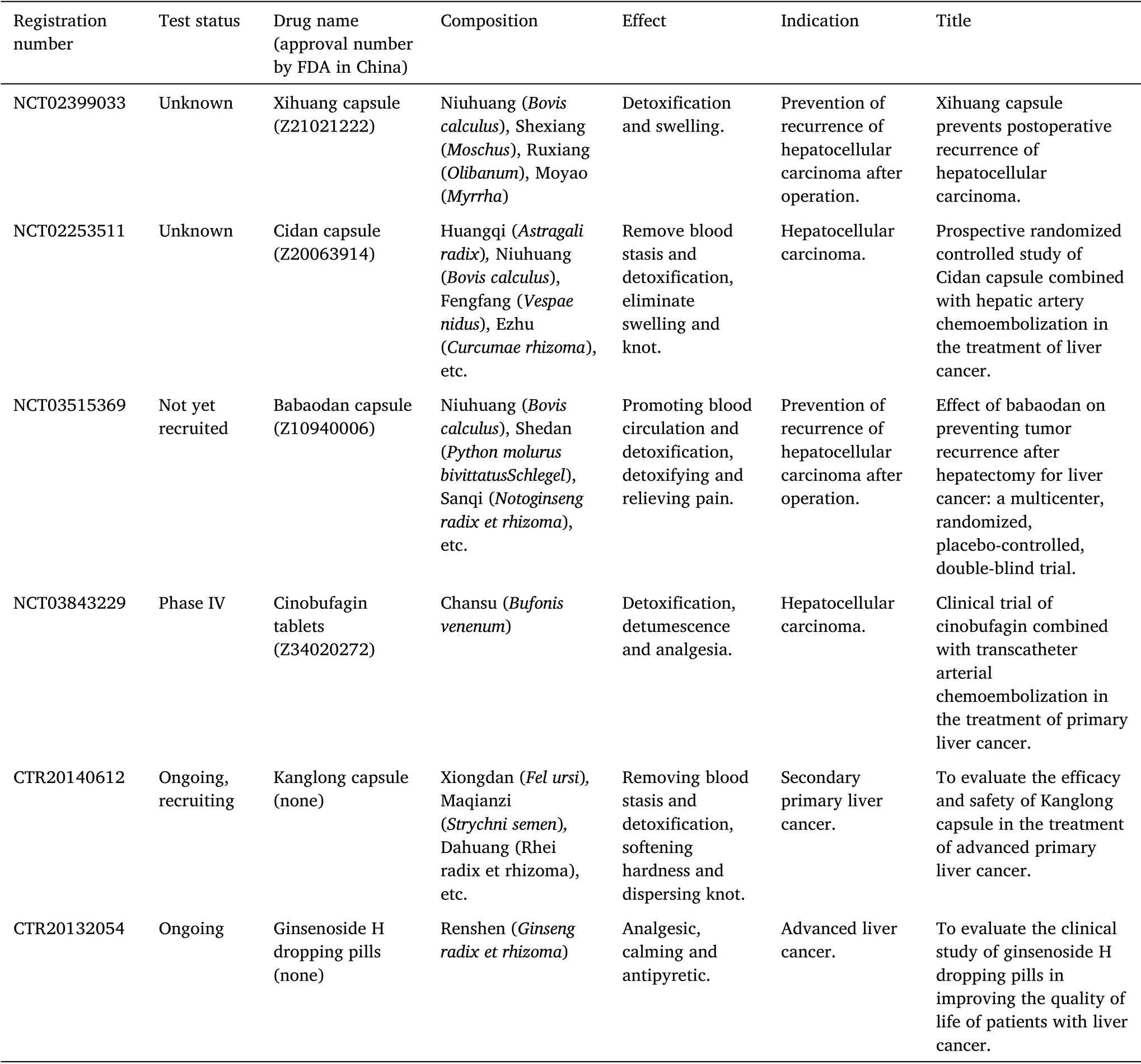
Table 4 Clinical trials of traditional Chinese medicine in the treatment of liver cancer
Cinobufotalin injection is a proprietary Chinese patent medicine that contains cinobufotalin as the main component (the approved number by FDA in China: Z34020274).It is often used in the comprehensive treatment of PLC.By increasing T cell growth factor(interleukin 2) and human interferon secretion and natural killer cell activity, Cinobufotalin injection can promote dendritic cell maturation and upregulate the expression of costimulatory molecules on dendritic cells to enhance immunity and anti-tumor ability [56].Zhou et al.recruited 1,142 patients (578 and 564 patients in the experimental and control groups, respectively) to conduct a blinded, randomized controlled trial evaluating the efficacy of TCM in treating advanced non-small cell lung cancer.Compared with that in the control group,the experimental group showed statistically significant improvements in objective tumor response, one-year survival rate, Karnofsky performance status, pain relief, and relief of serious side effects(nausea, vomiting, and leukopenia).This confirms that TCM plays a role in the adjuvant treatment of tumors [57].
Kang’ai injection is a Chinese patent medicine composed of Renshen(Ginseng radix et rhizoma), Huangqi (Astragali radix), and Kushen(Sophorae flavescentis radix) (approved number by FDA in China:Z20026868).It enhances immunity, induces apoptosis, and inhibits the invasion and metastasis of liver cancer cells [53].In the study by Wang et al., 89 patients with intermediate HCC were divided into two groups: the TACE + Kang’ai injection group (n = 48) with repeated TACE plus Kang’ai injection (n = 41), and the TACE only group (n =41).All patients underwent a prospective investigation.The primary endpoints were overall survival and time to radiologic progression.The median overall survival and time to radiologic progression were longer in the TACE + Kang’ai injection group compared to the TACE group.The 1 year, 2 years, and 3 years overall survival rates in the TACE + Kang’ai injection group were significantly higher than those in the TACE group, while the 1 year and 2 years overall survival rates in the TACE + Kang’ai injection group were significantly lower than those in the TACE group.The incidence of intra- and extra-hepatic metastasis and post-embolization syndrome in the TACE + Kang’ai injection group was significantly lower than that in the TACE group.In this non-randomized study, TACE plus Kang’ai injection was more effective than TACE alone in treating patients with intermediate HCC[58].
The Xiaoaiping injection, a Chinese patent medicine with the approved number by FDA in China: Z20063919, is extracted from the Tongguanteng (Marsdeniae tenacissimae caulis) Chinese herb [9].Modern pharmacological studies reported that Xiaoaiping injection inhibits the proliferation and induces the differentiation of cultured HCC cells, such as the human HCC cells, BEL-7404 and HepG2.It also improves the efficacy of 5-fluorouracil chemotherapy.In addition,Xiaoaiping injection is minimally toxic to immune and hematopoietic stem cells.However, Xiaoaiping injection can promote the proliferation of T and B lymphocytes [59].To evaluate the efficacy of the Xiaoaiping injection in the treatment of non-small cell lung cancer,24 studies were pooled with a total of 1,725 patients with advanced non-small cell lung cancer.Among them, 863 patients received Xiaoaiping injection combined with platinum chemotherapy as theexperimental group, while the remaining 862 patients received platinum chemotherapy alone as the active control group.The objective tumor response rate of the experimental group was better than that of the control group.The incidence of adverse events was lower and enhanced immune function was observed[60].
Jinlong capsule (approval number by FDA in China: Z10980041) is a pure, anti-tumor Chinese patent medicine that embodies the principle of “strengthening immunity to eliminate pathogenic factors”,and is composed of Shougong (Gekko),Jinqianbaicaohuashe(Bungarus parvus), and Qishe(Agkistrodon).Jinlong capsule can enhance immune function by increasing the activity of macrophages, killer cells and natural killer cells, lymphatic factors, inducing interferon, interleukin,and tumor necrosis factor [61].He et al.pooled 56 studies, including 25 clinical trials involving 2,161 patients, and reported that patients receiving combination therapy had significantly improved objective response rates compared to those receiving conventional therapy only.Eight clinical trials involving 1,014 HCC patients reported a significant increase in overall survival.Patients treated with Jinlong capsule and conventional methods had lower rates of adverse events,including leukopenia, hepatotoxicity, and myelosuppression [49].
The Fuzheng Huayu capsule is an effective anti-fibrosis Chinese patent medicine that can improve clinical symptoms (approval number by FDA in China: Z20020073).One study enrolled 842 patients, 270 of which received Fuzheng Huayu capsule for more than 6 months.The indexes of diabetes, hypertension, total bilirubin,glutamyl transferase, white blood cell count, prothrombin activity,and alpha-fetoprotein in the Fuzheng Huayu capsule group were higher than those in the control group.Creatine levels were lower in the Fuzheng Huayu capsule group.The incidence of PLC in the Fuzheng Huayu capsule group was significantly lower than that in the control group after more than 12 months of Fuzheng Huayu capsule therapy.Longer treatment durations with Fuzheng Huayu capsule lead to lower PLC incidence [62].
TCM has developed into a relatively mature medical system due to its application for thousands of years.However, the effectiveness and standardization of TCM in the treatment of PLC remain to be determined.The study provides clinical research data on TCM treatment, reasonably drawing on the principles and methods of epidemiology and evidence-based medicine to establish determining criteria.Predictions of corresponding action targets and mechanisms based on network pharmacology and metabolomics provide a scientific basis for efficacy determination.Despite various challenges,numerous clinical trials have been performed that support the development of TCM for liver cancer treatment.
The mechanism of Chinese herbal medicines in treating PLC
In China, TCM has long been used to prevent liver cancer and is viewed as an effective preventative treatment [63].Many TCMs have anti-inflammatory, anti-fibrotic, anti-lipotoxic, and anti-cancer activities, with the potential to improve liver disorders [64].The unique natural ingredients in TCM can play a significant role in preventing liver cancer by inhibiting cell proliferation, metastasis, and blood vessel formation;thereby, changing cell morphology, promoting cell apoptosis and autophagy, and triggering the cell cycle and other mechanisms [65].These biological pathways are interrelated and multiple targets are combined to achieve therapeutic efficacy.
TCM and the promotion of cell cycle stagnation
HepG2 cells treated with matrine presented reduced viability,increased apoptotic rate, blunted migratory response, and impaired proliferation capacity.Matrine can activate mitochondrial fission resulting in mitochondrial dysfunction and oxidative stress; thus,damaging energy metabolism and initiating apoptosis in a dose-dependent manner [66].Berberine is a natural isoquinoline alkaloid with low toxicity.It is present in several medicinal plants,including Xiaobo (Berberis kawakamii Hayata), Huanglian (Coptidis rhizoma),Baimaogen (Hydrastis canadensis), Huangqin (Scutellariae radix), Huangbai (Phellodendri chinensis cortex), and Baiqucai(Chelidonii herba).Berberine has anti-inflammatory, anticancer, and ameliorative effects in liver injuries [67, 68].Tumor protein P53 is a key tumor suppressor gene that is translated in damaged cells to initiate apoptosis through the expression of the p53 protein [69].Berberine activates the wild-type tumor protein, Tumor protein P53,which increases miR-23a expression in PLC leading to cell cycle disruption in G2-M (refers to from the gap phase 2 to the mitotic period) cells [70].Zhao et al.reported that evodogine could inhibit the proliferation and apoptosis of PLC cell lines in vitro and tumor formation in vivo, mainly by stimulating the Hippo-YAP signaling pathway, thereby inhibiting cell growth [71].
Induction of apoptosis and autophagy in cancer cells and inhibition of autophagy in normal cells by TCM
Apoptosis is one of the most extensively researched cellular processes in HCC.Autophagy, a process that promotes cell death, is considered a target for PLC treatment as it can promote anti-cancer therapeutic responses.The balance of the interaction between pro-apoptotic and anti-apoptotic factors in the cell determines the degree to which the cell approaches the apoptosis threshold [63].Cancer cells meet their growth and proliferation needs by mediating the nutrients produced through normal cell autophagy [72].Therefore, inhibition of normal cell autophagy or promotion of cancer cell autophagy can inhibit cancer development.Rhubarb is a type of TCM and food source, with rhein and emodin as the main bioactive components [73].Emodin induces autophagy and inhibits apoptosis of human hepatocytes through the PI3K/AKT/mTOR pathway [74].Matrine is an alkaloid that promotes HCC cell apoptosis by inhibiting mitochondrial autophagy and the PINK1/Parkin pathway [72, 75].Musk can improve the apoptosis and autophagy rates of PLC cells.Increased apoptosis occurs through endoplasmic reticulum stress, and musk-induced autophagy is closely associated with the AMP kinase/mTOR complex 1 signaling pathway[76].
Inhibition of angiogenesis and metastasis of cancer cells by TCM
Revascularization forms microcirculation, which provides early cancer cells with increased capillary blood supply and sufficient nutrients,thereby, enhancing replication.It also provides a pathway for cancer cells to metastasize through the blood vessels and lymph nodes.Blood vessels surrounding the tumor have weaker walls than normal blood vessels allowing tumor cells to cross into the blood and metastasize[77].Blocking and controlling blood vessel regeneration can effectively treat early-stage cancer.Tumor growth and metastasis depend on angiogenesis and the factors regulating it.Some TCMs target angiogenesis and affect the growth and reproduction of tumors in the human body.Dihydroartemisinin, a derivative of artemisinin,inhibits the invasion and migration of cancer cells by reducing the number of translationally controlled tumor proteins [78].Nansheteng(Celastrus orbiculatus thunb) extract downregulates hypoxia-induced epithelial-mesenchymal transformation of cancer cells to inhibit further invasion and migration [79].Resveratrol can inhibit angiogenesis by inhibiting glycolysis and modulating pyruvate kinase isozyme type M2 nuclear translocation in endothelial cells [80].Lycorine could decrease the expression of matrix metalloproteinases,especially matrix metalloproteinase-2 and matrix metalloproteinase-9,in a concentration-dependent manner [81].Matrix metalloproteinases are the main proteolytic enzymes involved in tumor cell invasion and metastasis.Emodin has a strong anti-angiogenic activity in fish- and triplenegativebreastcancer mice models[82].
The regeneration microenvironment and DNA methylation induced by TCM
PLC has many pathogenic factors, complex links, is largely influenced by gene regulation, and is easily mutated [83].Although its pathogenesis remains unclear, epigenetics plays an important role in the development and progression of liver cancer [84].Epigenetic modifications do not alter the DNA sequence but do affect gene expression and are inherited stably within or between generations.DNA methylation was the first epigenetic mechanism to be identified[83].Abnormal DNA methylation is thought to be the key to cancer onset and progression.Aberrant DNA methylation at specific sites in tumor-associated genes is associated with chromatin remodeling and aberrant gene expression in a variety of malignant tumors [85].According to Wang et al., DNA methylation can accelerate the formation of an abnormal liver regeneration microenvironment, cause angiogenesis and the formation of a microcirculatory system, provide a favorable environment for cancer cell proliferation and metastasis,and thus, promote the development of liver cancer [83].Therefore,targeting specific DNA methylation changes or inhibiting the abnormal liver regeneration microenvironment is a potential anti-hepatocarcinoma strategy.
Resveratrol inhibits DNA methylation, which is influenced by DNA methyltransferases (DNMT), including DNMT1, DNMT3A, and DNMT3B.However, resveratrol can block the transcription process,silence the MAML2 gene (a co-activator of the carcinogenic NOTCH signaling pathway), and significantly reduce methyltransferase protein expression [86]; thereby, achieving anticancer effects.In addition, vitamin C, which is abundant in fruits and vegetables, is also extensively involved in DNA methylation, and thus, plays an anti-tumor role [87, 88].
Regulation of innate immune response by TCM
Cancer growth and progression is associated with immunosuppression[89].Cancer patients’ innate immune function will generally present varying degrees of decline.It is also important to destroy cancer cells and regulate the immune function and microenvironment of the body.Hepatitis virus infection, chronic alcohol abuse, and lipid accumulation can disrupt the highly regulated hepatic immune system and induce harmful liver inflammation, which may lead to PLC [90].TCM is rich in chemical components, including alkaloids,polysaccharides, glycosides, and flavonoids.These components have a variety of physiological functions and can regulate the innate immune response to varying degrees [63].TCM can increase inflammatory factor expression and reduce the production of immunosuppressive cytokines.Saikosaponin, from Chaihu (Bupleuri radix), and especially its other species, saikosaponin A, saikosaponin C, and saikosaponin D,inhibited tumor necrosis factor and interleukin-18 production by increasing the CD4+/CD8+T cell ratio and interleukin-10 expression,reducing concanavalin-induced immune liver injury.In another study,saikosaponin A induced activation of the Wnt/β-catenin pathway, the expression of T cell factor 1 and lymphoid enhancer factor 1, and promoted osteogenic differentiation of bone marrow stromal cells,possibly indirectly regulating hematopoietic stem cell formation [91].
Various TCM mechanisms associated with liver cancer treatment remain to be determined.We found TCM to be highly diverse concerning the treatment of various cancers.For example, curcumin can treat cancer by regulating noncoding RNAs.Curcumin also sensitizes chemoresistant pancreatic cancer cells by inhibiting the expression of the polycomb repressive complex 2 subunit, enhancer of zeste homolog, and its related lncRNA plasmacytoma variant translocation 1.Curcumin can also directly inhibit cell migration by downregulating the expression of the HOX transcript antisense RNA,in HCC.It also has a completely different mechanism of action in different cancer types [87].Cinobufagin capsule, an anticancer drug widely used to treat gastric cancer, mainly inhibits the proliferation and migration of human gastric cancer cells through the Akt/mTOR pathway [92].Cinobufagin can also inhibit colony formation, cell invasion, migration, and apoptosis in HCC by inhibiting the ErbB/EGFR signaling pathway.This is consistent with the findings of a previous study on gastric cancer.Cinobufagin achieves the same therapeutic effect in different cancer types by inhibiting cancer cell proliferation through various signaling pathways [50].Moreover,Hugan tablets, a prominent TCM, have unique advantages in liver cancer treatment.Hugan tablets can reduce transaminase, repair damaged hepatocytes, help accelerate liver metabolism and protect hepatocytes, and also play an anti-tumor role by triggering autophagy,increasing microtubule-associated protein light chain 3II and beclin1 levels, and arresting the cell cycle in the G0-G1 (refers to from the gap phase 0 to the gap phase 1) by downregulating the expression of cyclin-dependent kinase 2 and cyclin-dependent kinase 4.Hugan tablets can destroy liver cancer cells, while simultaneously protecting normal liver tissue[93].
Conclusion
TCM plays a unique role in treating liver cancer by improving symptoms, reducing adverse reactions, and improving survival time and quality of life.TCM has played the same role as Western medicine,and TCM-based comprehensive treatment has gradually demonstrated its unique advantages.Although TCM is commonly used in clinical liver cancer treatment, some challenges remain.TCM is often questioned because of its complexity, holistic concept, and symptomatic research.The synergistic or antagonistic effects of various components in Chinese herbal medicine are still unclear and present a major drawback.Additionally, the unknown quality of TCM and the challenges associated with pharmacodynamic and toxicological mechanism analyses hinders its modern-day acceptance.The advantages of TCM in the treatment of liver cancer will become more apparent as research develops and is standardized, potentially providing a novel liver cancer treatment.
杂志排行
Traditional Medicine Research的其它文章
- Preparation and characterization of resistant starch type 3 from yam and its effect on the gut microbiota
- Study on technical efficiency of traditional Chinese medicine industry of the Belt and Road Initiative based on environmental complexity
- Yangxin Dawayimixike honey paste inhibits atherosclerosis in ApoE-/- mice by attenuating blood lipids and exerting anti-inflammatory activity
- Virtual screening of flavonoids from Jatropha gossypiifolia L.as potential drugs for diabetic complications
- Traditional herbal medicine as adjunctive therapy for colorectal cancer: a scoping review
- Acupuncture:a new method to treat tic disorders in children
